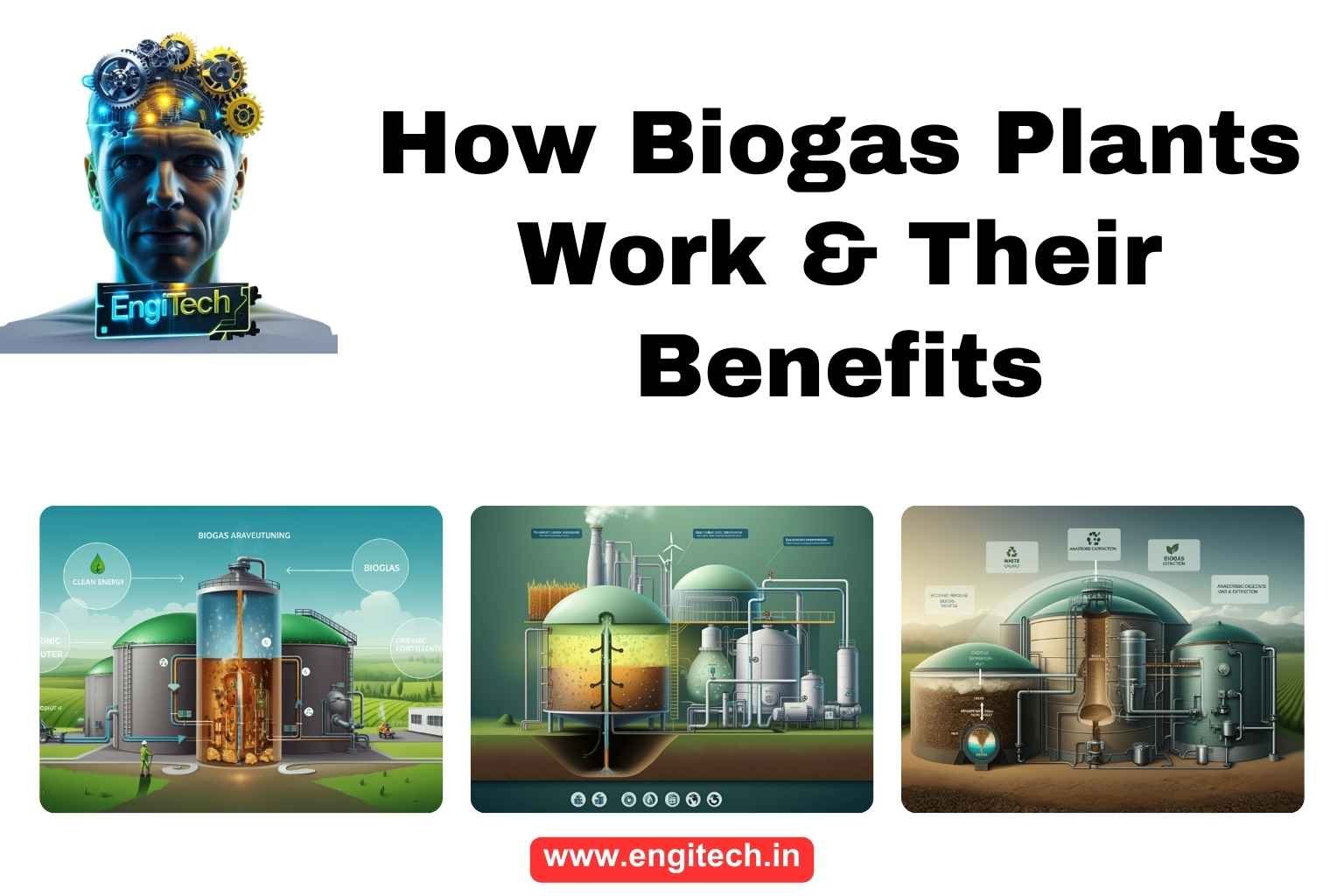Biofuels: The Future of Sustainable Energy – EngiTech

Imagine a world where clean, renewable energy sources aren’t just an option but a mainstream reality. A world where you can power your car, heat your home, and even fly across continents without burning fossil fuels. It may sound like an idealistic vision, but thanks to rapid advances in biofuel technology, that vision is closer than ever. Today, we’ll explore how biofuels are poised to become the future of sustainable energy—offering a cleaner, greener way to power our planet while tackling climate change head-on.
In the next few minutes, you’ll learn everything you need to know about biofuels: what they are, why they matter, and how they’re rapidly reshaping the global energy landscape. We’ll dig into real-world examples, break down the various production methods (including biodiesel production, ethanol as biofuel, and even algae into biofuel), and see how innovative solutions—such as Trualt Bioenergy and Bayo Gas—are revolutionizing this sector. By the end, you’ll understand why biofuels aren’t just a passing trend but truly the future of sustainable energy.
Table of Contents
A Brief History of Biofuels
Before diving into the complexities of biofuel production, it’s crucial to understand how we got here. Biofuels—fuels derived from organic matter—have existed in various forms for centuries. In fact, when Rudolf Diesel first showcased his diesel engine in the late 19th century, it ran on peanut oil, a type of biodiesel by today’s definitions.
However, the widespread adoption of fossil fuels—like petroleum and coal—overshadowed the development of biofuels for much of the 20th century. Cheap oil prices and established infrastructure led governments, industries, and consumers to favor petroleum-based products. It wasn’t until environmental concerns and volatile oil prices began to capture global attention that the world revisited the promise of greener, more sustainable alternatives.
The Turning Point
- Environmental Awareness: From the late 20th century onward, rising concerns about carbon emissions, air quality, and climate change drove scientists and policy-makers to look for low-carbon solutions.
- Energy Security: Major oil shortages in the 1970s underlined the need for secure, domestically produced energy. Biofuels, sourced from local agricultural byproducts or waste, offered a way to reduce dependence on oil imports.
- Technological Advancements: Innovations in agriculture and biofuel production processes made it more viable to convert organic material—ranging from corn to algae—into functional fuels such as biodiesel and ethanol biofuel.
These drivers laid the groundwork for the modern biofuels industry, which continues to evolve as we develop increasingly efficient ways to produce fuels from renewable, carbon-neutral resources.

What Exactly Are Biofuels?
Biofuels are fuels created from organic, renewable feedstocks. These feedstocks can include crops like corn and sugarcane, agricultural residues such as corn stover, forest residues like wood chips, algae, and even municipal waste. By harnessing the energy stored in these biological materials, biofuels offer an alternative to fossil fuels that can reduce greenhouse gas emissions and promote a circular economy.
First-Generation Biofuels
- Ethanol: Typically made from sugar- or starch-rich crops such as sugarcane, corn, or wheat. Known widely in markets like Brazil and the United States.
- Biodiesel: Produced from vegetable oils (e.g., soybean or canola) and animal fats. Biodiesel manufacturing has gained traction as a cleaner alternative to conventional diesel, helping reduce carbon emissions in the transportation sector.
Second-Generation Biofuels
- Cellulosic Ethanol: Instead of using the edible portions of crops, second-generation processes can break down cellulose—the fibrous material in plant matter—into sugars that can be fermented into ethanol.
- Bio Fuel Pellets: Compressed pellets made from waste wood, agricultural residues, or other biomass, used primarily for heating in residential and commercial settings.
Third-Generation Biofuels
- Algae Biofuel: By cultivating and processing algae, companies can produce algae fuel or algae bio fuel suitable for both diesel and jet engines. Algae energy is considered particularly promising because algae grows much faster than traditional crops and can be cultivated in areas that aren’t suitable for food agriculture (e.g., saltwater ponds, desert land).
Fourth-Generation Biofuels
- Biofuel Circle and Carbon Capture: In an ideal scenario, fourth-generation biofuels not only reduce emissions but also actively capture and store carbon from the atmosphere. Various research initiatives aim to combine advanced biofuel processes with carbon-capturing technologies, creating a net-negative emission cycle.
Why Biofuels Matter More Than Ever
- Climate Change Mitigation: Unlike fossil fuels, biofuels are often considered “carbon-neutral” because the carbon dioxide they release during combustion is roughly equal to the amount the feedstock plants absorbed while growing.
- Energy Security: By producing fuels locally—from algae ponds to crop residues—countries can reduce their reliance on oil imports, fostering greater economic and geopolitical stability.
- Rural Development: Farmers and rural communities benefit from new markets for their agricultural byproducts. Biofuel production can also create jobs and boost local economies.
- Waste Management: Some forms of biofuel utilize waste materials (e.g., used cooking oil, agricultural leftovers), effectively turning trash into valuable energy resources.
Inside Biofuel Production and Technology
The journey from raw biomass to a ready-to-burn fuel can involve several processes—fermentation, transesterification, gasification, and more. Let’s break down a few of the most common and advanced techniques, showcasing both the complexity and flexibility of modern biodiesel production and ethanol as biofuel processes.
Fermentation for Ethanol
- Feedstocks: Corn, sugarcane, wheat, or even cellulosic materials like grass and wood.
- Process: Enzymes or acids break down complex carbohydrates into simple sugars. Yeast then ferments these sugars into ethanol. The mixture is distilled to increase ethanol concentration.
- Final Product: Ethanol biofuel that can be blended with gasoline or used in flex-fuel vehicles.
Transesterification for Biodiesel
- Feedstocks: Vegetable oils (e.g., canola, soybean), animal fats, and increasingly, algae bio fuel sources.
- Process: Oils react with an alcohol (commonly methanol) in the presence of a catalyst (usually lye) to produce biodiesel (methyl esters) and glycerin as a byproduct.
- Final Product: Biodiesel that can often be used in diesel engines with minimal or no modifications.
Biodiesel Manufacturing Processes
- Batch Processing: Ideal for small-scale producers and farmers, this method involves smaller reactors for a step-by-step approach.
- Continuous Processing: For large-scale, industrial biodiesel production, continuous-flow reactors handle the transesterification process more efficiently.
- Supercritical Method: An advanced technique that does not require a catalyst, reducing the time and steps needed. Although more energy-intensive, it can process lower-grade feedstocks, including waste oils.
Biodiesel from Algae
Algae stands out because of its high oil content and rapid growth rates:
- Cultivation: Grown in open ponds or closed bioreactors.
- Harvesting & Drying: Algae biomass is harvested and dried to remove water, crucial for maximizing oil yield.
- Oil Extraction & Conversion: Oils are extracted via mechanical or chemical methods, then subjected to transesterification.
- Advantages: Minimal land requirement, potential to use salt or wastewater, and comparatively higher yield than conventional oilseeds.
Bio Mass Gasification
Bio Mass Gasification is another cutting-edge method where solid biomass (e.g., wood chips, agricultural residues) is exposed to high temperatures in a low-oxygen environment. The result is “syngas,” a mixture of carbon monoxide and hydrogen. This syngas can be further refined to create liquid fuels or used as a replacement for natural gas, often referred to as bayo gas in some regional contexts.
Algae into Biofuel: The Next Big Thing
If there’s one area poised to disrupt the entire biofuel landscape, it’s algae. Algae into biofuel isn’t just a scientific curiosity; it’s a frontier that could revolutionize how we power vehicles, airplanes, and even power plants. Here’s why algae holds so much promise:
- High Oil Content: Algae can contain up to 70% of its dry weight as lipids, perfect for biodiesel manufacturing.
- Rapid Growth: Many species of algae can double in mass within hours.
- Minimal Land Use: Unlike soybean or corn fields, algae farms can occupy non-arable land or fit into existing wastewater treatment facilities.
- Waste Utilization: Algae feed on carbon dioxide and nutrients, making them great for capturing emissions from power plants and utilizing wastewater.
Companies and research institutions worldwide—sometimes grouped in initiatives jokingly referred to as the Biofuel Circle—are experimenting with advanced techniques to cultivate algae at scale. This not only opens doors to greener transportation fuels but also holds promise for improved carbon capture and utilization strategies.

Sustainable Aviation Fuel
One of the most significant frontiers for biofuels is aviation. The pressure on airlines to reduce their carbon footprint has never been higher. Sustainable Aviation Fuel (SAF) derived from feedstocks like algae, cooking oil, or agricultural residues can help airlines lower their emissions by up to 80% over their lifecycle compared to traditional jet fuel.
Major airports and carriers are beginning to blend SAF into their fueling systems. While costs are higher at the moment—primarily due to limited supply and emerging technology—ongoing research, subsidies, and corporate sustainability commitments are fueling rapid expansion. As the airline industry looks to meet net-zero targets over the coming decades, biofuels stand front and center in these plans.
Environmental Benefits and Carbon Footprint Reduction
One of the main draws of biofuel is its potential to significantly reduce greenhouse gas (GHG) emissions compared to fossil fuels. When done responsibly—i.e., without displacing food crops or causing deforestation—biofuels can lead to substantial net reductions in carbon dioxide.
- Closed Carbon Loop: The plants (or algae) used to produce biofuels absorb CO₂ during growth. When the fuels are burned, that CO₂ is released back into the atmosphere, creating a relatively balanced carbon cycle.
- Reduced Air Pollutants: Biodiesel contains lower levels of sulfur and aromatics, resulting in fewer harmful particulates.
- Less Toxic Spills: Biodiesel is biodegradable and less toxic than conventional diesel, reducing environmental harm in the event of accidental spills.
However, these advantages hinge on responsible land management, feedstock selection, and the minimization of inputs like fertilizers and pesticides. It’s also essential to factor in the entire lifecycle of the fuel—from feedstock cultivation to distribution—to ensure the desired environmental benefits materialize.
Overcoming the Challenges of Biofuel Adoption
As promising as biofuels are, they’re not without hurdles. From technical barriers to economic constraints, the journey toward widespread biofuel adoption has its complexities.
Feedstock Availability and Competition
- Competing with Food Crops: Some critics argue that using crops like corn or soybean for biofuel could drive up food prices or encourage deforestation.
- Waste and Residue Utilization: To address this, many producers are turning to waste streams—such as used cooking oil, forest residues, or algae farms—so that biofuel production does not encroach on food supplies.
Cost and Infrastructure
- Production Costs: Advanced processes, especially those involving algae biofuel, can be expensive due to high research, equipment, and maintenance costs.
- Infrastructure Upgrades: Distributing high blends of biofuels may require changes in pipelines, storage facilities, and retail gas stations. Fleet modifications might also be needed for vehicles running on high ethanol blends.
Policy and Market Incentives
- Regulatory Support: Government policies, subsidies, and mandates can accelerate the adoption of biodiesel and ethanol. For instance, certain regions mandate blending a percentage of biodiesel with conventional diesel.
- Global Trade: Policies around importing and exporting feedstock materials can shape where and how biofuel production thrives.
Real-World Applications and Case Studies
Nothing underscores the potential of biofuels like actual success stories. From small farms to global corporations, countless examples highlight how biofuel is reshaping modern energy solutions.
Bio Fuel Pellets for Heating
In parts of Europe and North America, bio fuel pellets have gained enormous popularity for residential heating. These pellets—formed from compressed sawdust, wood chips, or agricultural residues—offer a cleaner, more efficient alternative to coal or heating oil. Many homeowners install pellet stoves or boilers, lured by stable pellet prices and lower carbon footprints.
Trualt Bioenergy and Bayo Gas Innovations
- Trualt Bioenergy: Known for integrating small-scale biogas digesters in rural communities, Trualt Bioenergy converts organic waste into a methane-rich gas—often referred to as “bio gas.” This gas can be used for cooking or generating electricity, reducing reliance on propane or firewood.
- Bayo Gas: A new wave of companies is specializing in large-scale bio mass gasification systems, turning agricultural residues and forestry waste into syngas or bayo gas, which can then be refined into transportation fuels or used directly for heat and power.
Bioethanol Tesco
In the United Kingdom, major retailers have started offering E10 fuel blends (10% ethanol, 90% gasoline). The rise of Bioethanol Tesco—a term often used by British motorists who notice the bioethanol blend at Tesco fuel stations—is emblematic of broader acceptance. This shift to higher ethanol blends helps cut down on greenhouse gas emissions without requiring consumers to change their regular fueling habits significantly.
Biofuel Circle: Collaboration, Innovation, and Knowledge Sharing
The journey to mainstream biofuel adoption involves multiple stakeholders—farmers, scientists, policymakers, corporations, and consumers. The Biofuel Circle is less an official organization and more a collaborative ethos embracing:
- Open-Source Research: Sharing breakthroughs in algae fuel cultivation, biodiesel manufacturing, and bio mass gasification to spur global innovation.
- Community Engagement: Encouraging local communities to adopt small-scale biodigesters or pellet systems for heating and cooking.
- Education and Advocacy: Raising awareness about sustainable farming practices and feedstock selection, ensuring biofuels remain genuinely carbon-neutral.
This sense of collaboration accelerates breakthroughs and helps address common challenges—like feedstock logistics and public perception—more rapidly.

FAQs: Your Top Biofuel Questions, Answered
Below, we’ve gathered some of the most common questions people have about biofuels. If you’re considering adopting, investing in, or learning more about this sustainable energy source, these insights should guide you in the right direction.
1. Is Biofuel Really Carbon-Neutral?
Biofuel is generally considered carbon-neutral because the CO₂ released during combustion roughly equals the amount the feedstock absorbed during growth. However, the overall carbon footprint depends on the entire lifecycle (land use, transportation of feedstocks, production methods). Sustainable practices and advanced technologies minimize any additional emissions, keeping biofuels as close to carbon-neutral as possible.
2. Can Biofuel Damage My Engine?
Most gasoline and diesel engines can handle low-level biofuel blends (e.g., E10 ethanol, B5 biodiesel) without any issues. Higher blends may require engine modifications or specialized vehicles. Always check your manufacturer’s guidelines before using higher-concentration biofuels.
3. What About “Food vs. Fuel” Concerns?
While first-generation biofuels use food crops like corn or soybeans, newer technologies focus on waste products, non-edible crops, or algae into biofuel. These practices alleviate the pressure on food supplies and reduce the environmental footprint associated with feedstock cultivation.
4. Is Algae Biofuel Ready for Commercial Use?
Algae-based fuels show huge promise, but they remain in the early stages of commercialization. Research is ongoing to reduce costs, improve yields, and scale production. Experts project algae fuels could become a significant player in both aviation and ground transport within the next decade, especially as the costs drop and processes become more efficient.
5. What Is the Difference Between Biogas and Bayo Gas?
Both terms can refer to gas derived from biomass or organic waste. “Biogas” is commonly used for methane-rich gases from anaerobic digesters, while “Bayo Gas” may refer to syngas or specialized blends from bio mass gasification systems. In many cases, they’re variations of the same process with slight differences in composition and production methods.
Conclusion—Seizing the Biofuel Opportunity
As our global community seeks cleaner, more resilient energy solutions, biofuels stand at the forefront of innovation. From biodiesel manufacturing to ethanol as biofuel, from bio fuel pellets to algae bio fuel, the advancements we’ve witnessed in recent years are nothing short of remarkable. If you’ve been wondering whether biofuels: the future of sustainable energy is just a lofty claim, the overwhelming evidence suggests it’s a reality already in motion.
Now is the time to join the movement. Whether you’re a policymaker looking to set ambitious renewable energy targets, a business leader exploring cost-effective and eco-friendly solutions, or an individual eager to reduce your carbon footprint, biofuels offer a tangible, impactful path forward.
- Share This Knowledge: Forward this post to friends, colleagues, or community groups to spark meaningful discussions on transitioning to cleaner fuels.
- Explore Real-World Solutions: Research local projects—like Trualt Bioenergy, Bayo Gas, or Bioethanol Tesco—to see how biofuels are reshaping energy right in your backyard.
- Take the Next Step: If you’re part of an organization seeking lower emissions, consider pilot projects using biodiesel blends or bio mass gasification systems. Or, if you’re a consumer, opt for higher biofuel blends at the pump.
By embracing biofuels—from algae fuel to bio fuel pellets—you’re not just fueling your vehicle or warming your home. You’re fueling a global shift toward sustainability, energy independence, and a healthier planet for future generations. Let’s power our world responsibly and ensure that biofuels: the future of sustainable energy becomes more than just a vision—it becomes our shared reality.
Stay Connected with EngiTech
EngiTech is your trusted source for in-depth knowledge on industrial mechanical engineering machines and technologies. Stay ahead with the latest innovations, expert insights, and practical guides designed to help you make informed decisions for your business and engineering needs. Join our growing community of professionals and industry leaders to stay updated and competitive in the ever-evolving world of industrial technology.


